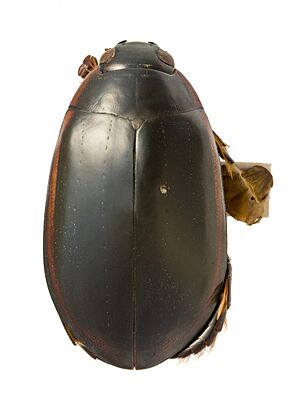Megadytes ducalis facts for kids
Quick facts for kids Megadytes ducalis |
|
|---|---|
 |
|
| Holotype of Megadytes ducalis, the first specimen, at the Natural History Museum, London | |
| Conservation status | |
| Scientific classification |
Megadytes ducalis is a very large water beetle. It belongs to a family called Dytiscidae. This beetle is special because it's the biggest known species in its whole family! For a long time, people only knew about one single beetle specimen. It was found in Brazil way back in the 1800s. But in 2019, more specimens were found, also from the 1800s and from Brazil. Even though it's listed as extinct (meaning it's thought to have died out), scientists believe it might still be alive. This is because not many studies have been done on water beetles in Brazil.
Contents
The Story of Megadytes ducalis
The very first M. ducalis beetle was found in the 1800s. Nobody knows the exact place in Brazil where it was collected. This first specimen is now kept at the Natural History Museum, London. There were stories that it was found at the bottom of a canoe in the Amazon rainforest.
More Beetles Discovered
In 2019, scientists made an exciting discovery. They found 10 more specimens of M. ducalis! These beetles were also collected in the late 1800s. They were found by chance in the National Museum of Natural History of France. Among these new finds was the very first female of the species ever seen.
The first beetle found didn't have a clear location. But the new specimens showed they were all collected in a place called Santo Antonio da Barra. This area is now known as Condeuba, in the southern part of Bahia, Brazil. People in that region used to trade insects. They would catch special beetles like Hypocephalus armatus for collectors.
Is It Extinct?
Because no Megadytes ducalis beetles have been seen recently, the IUCN (International Union for Conservation of Nature) lists it as extinct. However, scientists don't have much information about this specific beetle. Also, not many studies have been done on water beetles in Brazil. This means there's a chance that Megadytes ducalis might still be living in the wild.
What Megadytes ducalis Looks Like
Megadytes ducalis is a very large and strong beetle. It can be about 4.3 to 4.7 centimeters long. That's almost as long as your thumb! It is much bigger than other beetles in the same group, like M. lherminieri and M. magnus. It also has a slightly different shape, not as wide and oval as its relatives.
Male vs. Female Beetles
Both male and female M. ducalis beetles look quite similar from the outside. But there are a few small differences. Female beetles have a shiny back (dorsal surface) with no lines or grooves. Male beetles have special pads on their front legs (protarsal disks). They also have yellow hairs on the underside of one of their middle leg segments. These features are not found on the females.
Where Megadytes ducalis Lived
This beetle seems to have lived in a specific type of grassland called the cerrado. The only known specimens came from Condeuba in Bahia, eastern Brazil. If this beetle is still alive today, it is probably in great danger. Its home (habitat) is likely being destroyed.


